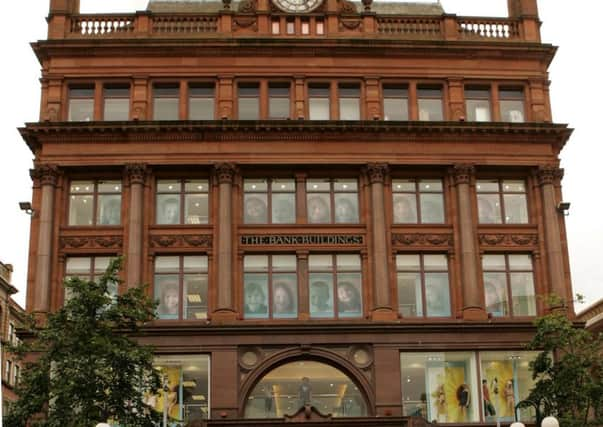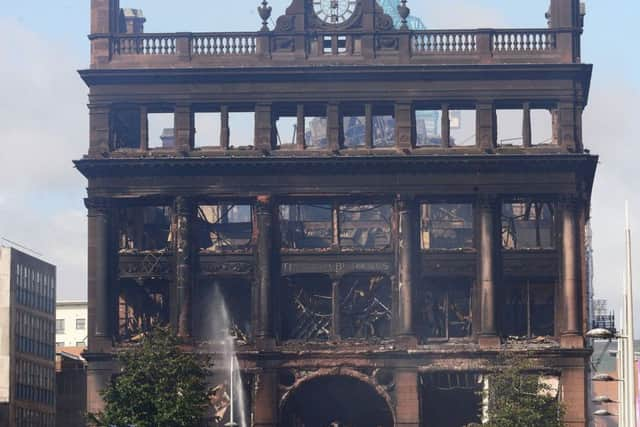Every time a grand old building is lost in Northern Ireland it is replaced by a lesser one, and is another small dent in our civilisation


Our reporter Graeme Cousins talked to people in central Belfast about the cordon around the famous property, that once housed Primark.
The disastrous fire last month has not only ruined one of the city’s most thriving and popular businesses, it has destroyed a grand old building and now seems set to inflict grave damage on neighbouring businesses that have to close because they are withing the cordon.
Advertisement
Hide AdAdvertisement
Hide AdThat restriction is set to last past the Christmas trading season.


Given that some of those businesses earn tens of thousands of pounds a day, and given that there are said to be seven security men guarding the cordon 24 hours a day, and given that Primark alone has lost tens of millions of pounds, it seems that the total losses could be well above £50 million.
Perhaps much more.
It is a reminder of what a massive business insurance is — risky, as Lloyds of London found in the 1980s, but also very lucrative (relatives of mine lived for a while in Bermuda, which is a capital of reinsurance, in which insurers insure themselves, and it experienced an economic boom after September 11 2001).
The depressing aspect of Graeme’s story was, obviously, the suffering that the fire has caused to nearby businesses, but also the growing view that Bank Buildings should be flattened to avoid economic loss.
Advertisement
Hide AdAdvertisement
Hide AdNow even I, a fan of old buildings, concede that livelihoods are more important than structures. Ultimately there comes a price that is not worth paying, no matter how impressive and important the building.
But even so, the loss of a property like Bank Buildings is a tragedy.
This is not to say it was the most beautiful building in Belfast (an architectural historian sent me a description of it in a book as an “ungainly looking stone clad brute”).
It is a loss because buildings are not built to anything like that standard any more.
Advertisement
Hide AdAdvertisement
Hide AdThe decline in the quality of the best buildings has been a small decline in our civilisation.
Almost every building that survives in Northern Ireland from before the First World War is of good quality, often outstandingly so.
Almost nothing built after the Second World War is noteworthy at all, with a handful of exceptions such as the Bar Library or Northern Bank.
I imagine this is because buildings in the 1800s were built on what would today be considered slave wages, and after 1945 this was no longer considered to be acceptable and so the costing of building to a high quality soared.
Advertisement
Hide AdAdvertisement
Hide AdEverywhere you go in Northern Ireland there are old buildings from the 1700s and 1800s that are both pretty and sturdy, with a high proportion of them being churches (particularly the earlier buildings, some of which are as old as this newspaper, 1737).
Even in deprived pockets of Belfast or Londonderry or Newry there are solid, attractive terraced houses with fine brickwork.
Modern stuff, even when well built, is rarely in the same league.
Sadly, traditional cottages in the countryside are almost non existent now, and less common even than they were when I was a child (wen they were already uncommon), flattened to make way for more practical but uglier bungalows.
Advertisement
Hide AdAdvertisement
Hide AdI noticed a heart-breaking brochure in an estate agents some years ago for a classic Ulster white cottage in Co Down that was being sold as a site. It didn’t even seem to occur to anyone that it might be worth restoring.
Almost every time an old building comes down, it is replaced by a lesser one.
Note how developers rarely want to flatten post war cheap buildings but instead older ones, because they are more costly to maintain.
I would abolish VAT on repairs or refurbishments of old buildings if they keep their period features.
Advertisement
Hide AdAdvertisement
Hide AdEven ‘Areas of Townscape Character’, like Bangor west, which are supposed to protect an environment of pretty buildings have been shown to be legally toothless, and planners have allowed demolition of fine Edwardian homes for modern replacements of lower quality.
Belfast has one of the most handsome city centres in the UK but almost every time a magnificent old building has come down it has been replaced by a dud.
It might be that Bank Buildings will have to come down for economic and safety reasons.
But it will be a another small dent in our civilisation if it does.
• Ben Lowry (@BenLowry2) is News Letter deputy editor